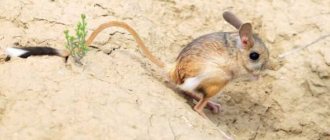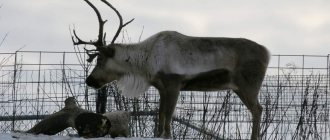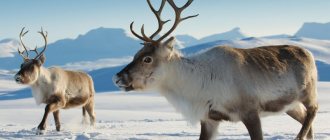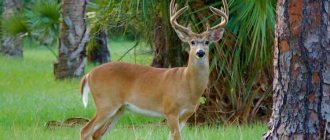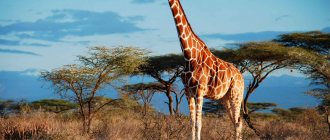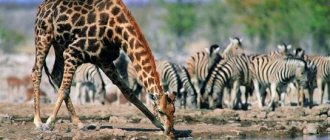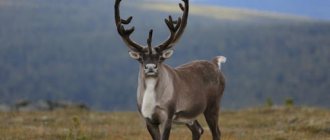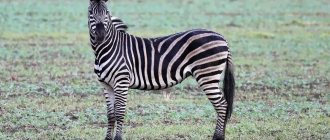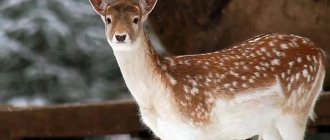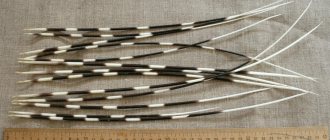№1
Male reindeer grow up to 70-135 centimeters in height and reach a length of about 1.8-2.1 meters. Females are usually smaller, about 1.7-1.9 meters in length. The body weight of males is in the region of 65-240 kg, and females - from 55 to 140 kg.
Reindeer are the only member of the deer family in which both males and females grow antlers. Males lose their antlers every year immediately after the mating season, around the beginning of winter, and females shed their antlers in the summer.
Where do they live?
Representatives of the deer family live on all continents of the planet.
In order to preserve certain species and increase the number of animals, animals are often taken outside their normal habitats and placed in nature reserves and zoos. Here they easily adapt to new living conditions thanks to their good adaptive abilities. In the wild nature of Russia, deer are most common in:
- regions of the Far North;
- Far Eastern Primorye;
- East and West Siberian taiga;
- spurs of Khamar-Daban, Sikhote-Alin ridge;
- mountains of Altai, Cis-Urals, North Caucasus;
- forests of Karelia, Bryansk region, Crimea.
Deer are bred as agricultural and game animals in farms and hunting farms in the Moscow region, Tver, Kaluga, and Yaroslavl regions.
№2
These are very social animals. They feed, travel and rest in large groups. Typically, herds range from 10 to 100 individuals. In the spring, herds can become even larger, up to 50,000 individuals (most often such herds are found in Russia). Herds very often travel south, covering vast distances (from 1500 to 3000 km) in search of food in winter.
Reindeer husbandry as a business
The first step to building any farm is registering an enterprise. To do this, it is recommended to register a peasant farm, which is taxed according to a simplified or traditional system. In this case, it is possible to avoid paying taxes on sales for five years.
To register, it is usually enough to present your passport and identification code to the tax office. A company can be registered by one person or several. When registering, the type of activity must be indicated (in our case, livestock farming). In this direction, it is more profitable to work in the direction of breeding deer, but for this the farm must operate for more than three years, observing sanitary and veterinary standards. Commercial farming does not require additional certification.
Experts recommend breeding deer in semi-natural conditions, which are organized as follows:
- The territory close to the forests is being purchased.
- An area is fenced off on the territory for the settlement of young animals.
- The fenced-off space is divided into sections. As a rule, there are three of them: for females, for males and for mating.
However, this also has disadvantages. For example, the natural enemies of deer are wolves and bears, as well as other large predators, if they are found nearby, they can attack and injure deer, which brings great losses.
Such production can produce the following products:
- Meat and meat products.
- Antlers
- Ecotourism.
- Wool.
№3
Deer are herbivores, meaning they eat only vegetation. Their diet includes grasses, ferns, mosses, shoots, mushrooms and leaves. On average, an adult deer eats about 4-8 kg of vegetation daily.
In winter, when there is less food, they tear up the snow with their horns and look for moss lichen, also known as “reindeer moss.”
Deer diet
Deer, like many other herbivores, feed mainly on leaves, grass and the bark of young trees. They do not hesitate to add mushrooms, berries, mosses and nuts to their diet, which contributes to the rapid development and growth of young individuals.
Necessary minerals and salts are obtained by finding natural salt deposits in the soil, which allow you to replenish the required balance of microelements.
№4
The gestation period in females lasts about 7.5 months. As a rule, females give birth to only one baby at a time, although there have been cases where one female gave birth to as many as four babies. At birth, the baby weighs from 2.5 to 9 kg.
Immediately after birth, babies can stand on their feet. Within a week, they begin to eat solid food in addition to their mother's milk. Deer become fully mature at 4-6 years of age. As for the average life expectancy, it is 15-18 years.
Reproduction and offspring
Fights between males for the right to own a female can be observed in mid-autumn. After mating, the female carries her future offspring for 8 months. After the first melting of the snow, one calf is born, although there have been cases when a female deer gave birth to two calves. Already on the second day, the fawn is able to stand on its feet and accompany its mother, being close to her.
Interesting fact! Within a week, the fawn easily swims across a small river, following its mother. After a couple of weeks, the cubs begin to develop antlers.
The female feeds her young with milk until the onset of winter. After 5 years of life, the young become fully mature and ready to reproduce.
№8
It is believed that reindeer were domesticated by Arctic peoples at least 3,000 years ago (some scientists believe as much as 7,000 years ago). This happened in Northern Europe (Lapland). They are still the only species of deer that are widely used as pets. They are used as mounts and also receive meat, milk and hides from them.
Population and species status
If we talk about the world population of deer, today it is more than 15 million individuals. The decrease in the total number of reindeer is associated both with hunting and with the economic activities of humans, who thoughtlessly cut down forests, pave roads, and graze their domestic reindeer.
Currently, wild reindeer are easy prey for hunters and poachers. Active hunting and the active activity of poachers have led to the fact that wild deer remained only in too remote places inaccessible to humans.
Some reindeer species are protected in natural protected areas, as well as under the protection of the Red Book.
Alaska Wildlife (Reindeer)
№9
These animals are adapted to life in conditions of long winters and very low temperatures. They can be found in Alaska, Canada, Greenland, Northern Europe and northern Asia. They live in tundras, mountains and inhospitable forests.
They are uniquely equipped to survive in extreme weather conditions. For example, their nose works as a “heater”. It warms the incoming air before it reaches the lungs. It also "pulls" water from the air to keep the nasal mucosa moist. This is an amazing organ.
But it’s not just their nose that helps them survive in such conditions. Their fur traps air, creating an air cushion that insulates the body from the cold. It also protects the animal from cold water when it needs to cross the river.
Their legs are also unique. Their hooves adapt depending on the season. During the winter, the pads on the bottom of their feet shrink and begin to resemble pickaxes, which help them break ice to find food. In spring, their pads expand again, which improves traction.
In addition, it is worth noting that they can lower the temperature of their feet down to -10 degrees Celsius in order to keep the rest of the body warm.
What do they eat?
Being herbivores, deer eat parts of plants.
In the warm season they eat:
- leaves and shoots of trees, shrubs;
- herbs;
- cereals;
- fruits;
- berries;
- mushrooms;
- nuts;
- chestnuts.
In winter, in the absence of succulent food, they eat pine needles, fallen acorns, lichens, and gnaw the bark. To satisfy the need for minerals, animals look for natural salt marshes, springs with mineralized water, and eat soil.
Their main food in captivity is:
- hay;
- fresh grass;
- branches, shoots of bushes;
- roots;
- apples;
- alfalfa pellets;
- compound feed
The general feeding system in zoos is similar to feeding livestock, which does not require much grain.
№10
Despite the fact that this is a fairly large animal, it has many enemies. Eagles and other large birds of prey may attack newborn fawns.
Adults are attacked by bears, but they are not their main source of food.
As for the main enemy, these are wolves. Wolf packs regularly follow groups of deer and attack both sick individuals and children, as well as adult deer.
Natural enemies
Living in natural conditions, deer are forced to hide from a large number of enemies. The herbivore is regularly attacked by wolves, bears, tigers, hyenas, leopards and other predators that live in the same territories. If a deer senses danger, it will try to hide as quickly as possible. However, some individuals calmly treat people, and even go out to meet them without feeling a threat.
In winter, it is most difficult for an animal to hide from predators. Deer move more slowly through snowdrifts. Moreover, snow often covers edible shrubs and vegetation. Because of this, the creature has to make more effort to eat. And often in winter, predators find hungry and tired deer, which become easy prey.
What type of symmetry does a roe deer have?
Answer: bilaterally symmetrical animal.
Interesting materials:
What is the subject of general linguistics as a science? What causes STIs? What causes a tsunami? What causes air pollution and what are its consequences? What are the signs of coma? What is the result of the examination? What is the content of civil law? What is an essential condition of an employment contract? What is the purpose of surveillance? What's interesting at VDNKh now?
